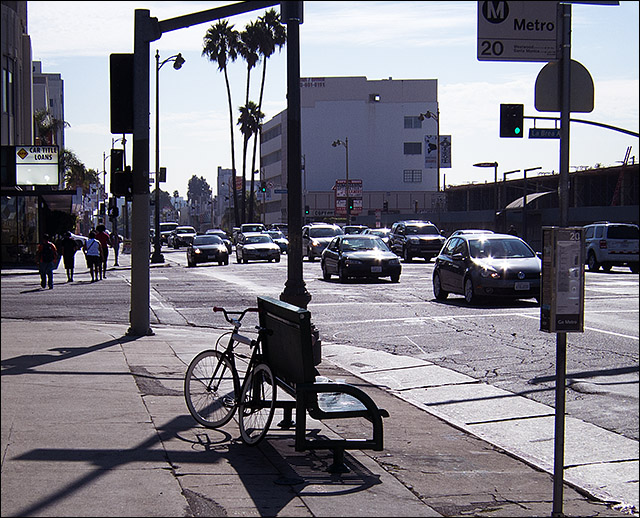 Often it’s the little things that help a city work—bike racks are a case in point, as are public trash cans, pocket parks, sidewalk café seating, and such. All slight adjustments of the common realm that make life more pleasant, less stressful, more productive.
Often it’s the little things that help a city work—bike racks are a case in point, as are public trash cans, pocket parks, sidewalk café seating, and such. All slight adjustments of the common realm that make life more pleasant, less stressful, more productive.
But so often municipal administrations are mired in procedural and perceptual habits, and ignore small matters that could have a big import when spread out over the city and into the future.
Regular readers of my various blogs know that I write often about how Metro, the public transit agency, gives short shrift to bike parking at its rail stations—even though it is known worldwide nowadays that cycling is one of the access modes that does the most to make transit useful to city folk—giving each bus stop or train station three times the reach into the neighborhood it serves than dependence on just walking can do.
Or dependence on cars: I’ve carped often enough lately on how the Expo Line’s La Cienega and Jefferson station gives a vast expensive parking structure free to drivers—thereby ensuring more, not less, traffic to and from that intersection—while cyclists have a few sidewal racks and a handful of lockers that they’d have to pay for.
Then there are just plain bus stops, such as in the photo above. You see a bike locked to the brace along the back of the bus bench, this couldn’t have hap[ened with the old ugly plastic benches, but the charming new metal ones make it clumsily possible.
I have asked, Why not make a slight modification to the bench to add a loop that makes it easy to park one or two bikes behind it, out of everyone’s way? LADOT can’t, they have told me. put bike racks too near bus stops, because they would interfere with boarding. But the benches are already taking up space on the sidewalk, and a biek oor two shackled behind each bench would not interfere with anything on the wider sidewalks around town, which are mostly the ones that have bus benches.
I did not just ask rhetorically; I wrote a formal letter to Metro about it. They said they thought about it, but that it would be too hard to coördinate with the advertising contractor who has the bench concession. Specifically, they said:
At this time, after discussions with our contractor, we are not going to pursue the cyclehoop. The contractor is under a contractual requirement to replace all of the old benches within a two year window, as well as adding benches were we were deficient, and the change would require re-engineering, new plans, etc. We will keep your idea on file and reconsider it at a later date.
The “later date” may well mean “never,” but I’ll hold out hope.
It would be terrible to lose this opportunity that could be implemented so cheaply–probably for no more than the cost of a sidewalk bike rack per bench, in my estimation.
Bikes and transit are a natural partnership that cities from Tokyo to Berlin exploit, putting bicycle facilities of all sorts by bus and train stops. Only the US mostly ignores that rich possibilities inherent in this first mile/last mile paradigm (though Portland and the Bay Area are getting better).
While LA chokes on car traffic—literally as well as figuratively— we throw away chance after chance to make Metro work like any other first-world transit system. It’s a pity.
One Comment
I see all those new bus benches as Bike racks. All they require is a big ulock or a cable. Having them all over is a vast improvement in bike parking. That’s 6,000 new bike racks, covered as bus benches. And they are in populated visible areas out on the street too!
A very unexpected and very welcome addition to bike infrastructure. Nothing could be locked to the old benches.
Ok, a better loop to lock to would be nice. Maybe we can make something?